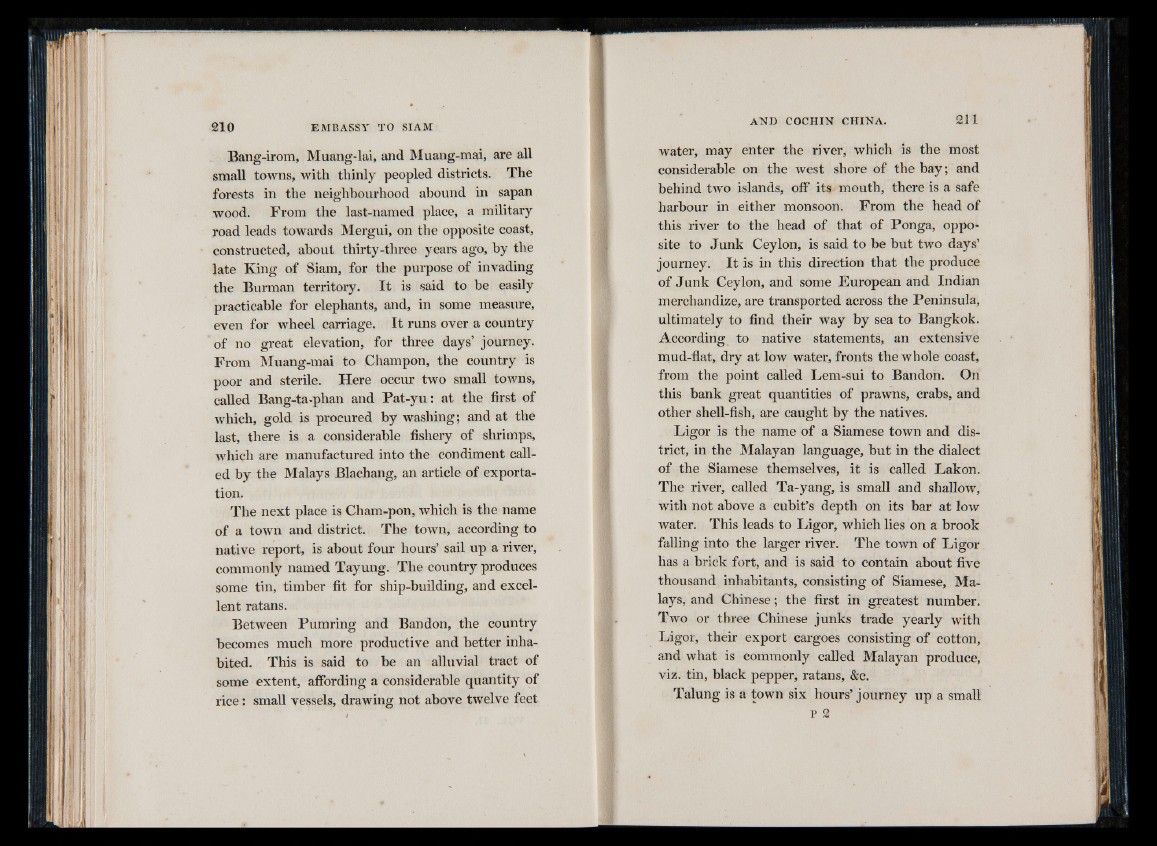
Bang-irom, Muang-lai, and Muang-mai, are all
small towns, with thinly peopled districts. The
forests in the neighbourhood abound in sapan
wood. From the last-named place, a military
road leads towards Mergui, on the opposite coast,
constructed, about thirty-three years ago, by the
late King of Siam, for the purpose of invading
the Burman territory. I t is said to be easily
practicable for elephants, and, in some measure,
even for wheel carriage. I t runs over a country
of no great elevation, for three days’ journey.
From Muang-mai to Champon, the country is
poor and sterile. Here occur two small towns,
called Bang-ta-phan and Pat-yu : at the first of
which, gold is procured by washing; and at the
last, there is a considerable fishery of shrimps,
which are manufactured into the condiment called
by the Malays Blachang, an article of exportation.
The next place is Cham-pon, which is the name
of a town and district. The town, according to
native report, is about four hours’ sail up a river,
commonly named Tayung. The country produces
some tin, timber fit for ship-building, and excellent
ratans.
Between Pumring and Bandon, the country
becomes much more productive and better inhabited.
This is said to be an alluvial tract of
some extent, affording a considerable quantity of
rice : small vessels, drawing not above twelve feet
water, may enter the river, which is the most
considerable on the west shore of the bay; and
behind two islands, off its mouth, there is a safe
harbour in either monsoon. From the head of
this river to the head of that of Ponga, oppo*
site to Junk Ceylon, is said to be but two days’
journey. I t is in this direction that the produce
of Junk Ceylon, and some European and Indian
merchandize, are transported across the Peninsula,
ultimately to find their way by sea to Bangkok.
According to native statements, an extensive
mud-flat, dry at low water, fronts the whole coast,
from the point called Lem-sui to Bandon. On
this bank great quantities of prawns, crabs, and
other shell-fish, are caught by the natives.
Ligor is the name of a Siamese town and district,
in the Malayan language, but in the dialect
of the Siamese themselves, it is called Lakon.
The river, called Ta-yang, is small and shallow,
with not above a cubit’s depth on its bar at low
water. This leads to Ligor, which lies on a brook
falling into the larger river. The town of Ligor
has a brick fort, and is said to contain about five
thousand inhabitants, consisting of Siamese, Malays,
and Chinese; the first in greatest number.
Two or three Chinese junks trade yearly with
Ligor, their export cargoes consisting of cotton,
and what is commonly called Malayan produce,
viz. tin, black pepper, ratans, &c.
Talung is a town six hours’ journey up a small
P 2